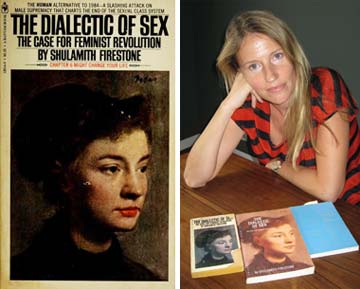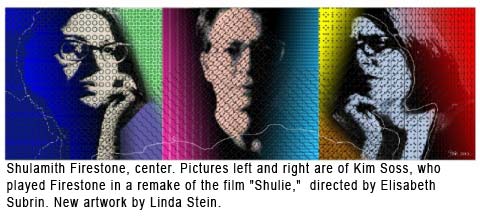by Jennifer Baumgardner

Almost 15 years ago, I picked up my ringing phone and the voice on the other end identified herself as Shulamith Firestone. I almost dropped the receiver.
Second wave feminism had many iterations and reverberations. As readers of On The Issues Magazine no doubt know, some women, like Betty Friedan and Helen Gurley Brown, claimed space for women in previously male activities and institutions. But the activists and thinkers who actually created the Women’s Liberation Movement didn’t want what men had; they wanted freedom from patriarchal, woman-hating culture with its pre-programmed roles and compliance with our biological destiny.
Shulamith Firestone was, briefly, the most significant producer of radical feminist theory and organizing. Between 1967 and 1969, she co-founded New York Radical Women, Redstockings and New York Radical Feminists. She was among the first to reclaim the suffragists as radical forbears rather than irrelevant, racist pragmatists. In 1970, she published The Dialectic of Sex—a cogent, shocking, albeit witty best-seller that attempted to liberate women from traps of sexism misunderstood as vital and positive. These traps included romantic love and procreation.
When that call came I was in touch with many second wave feminists, but no one I spoke with knew how to reach Shulamith or anything about how she survived since, decisively, quitting the movement she helped launch. Not one to show up at Veteran Feminists of America gatherings or 92nd street Y panels, she didn’t appear to want to dine out on her past or even preserve it. She was the rarest bird.
That day in 1998 Firestone informed me she had written a small book of interconnected stories called Airless Spaces, her first published work after The Dialectic of Sex; she hoped that I could review it. You have to understand: meeting the women who created radical feminism felt like my life’s work. Alice Echols’ 1989 Daring to Be Bad was my guidebook, alerting me to the conditions and personalities that led to the explosion of theory and action that became contemporary feminism. I had searched for years for word of Shulamith. Earlier that year I had met Elisabeth Subrin, a talented younger filmmaker who made a frame-by-frame reproduction of a film made about Shulamith (“Shulie”) from her art student days. Subrin hadn’t met Shulamith but told me that she had heard from an intermediary that Firestone disliked the original film and didn’t see how Subrin’s homage was any different.
That out-of-the-blue call from Shulamith led to the two of us meeting. She lived, it turned out, just a few blocks from me in the East Village. She had short, brushed back hair, an open smile and a short, trim body clad in jeans and sneakers. She wore a denim jacket and was fun and genuine. We had dinner, she came to an event I held in which second wave and third wave feminists read each others’ work, we grabbed beers at St. Dymphna’s. I even asked her about Subrin’s film and she said her critique was that the actress portraying her in the film didn’t have anything approaching her fire. Hers was a unique intellect and uniquely powerful charisma.
During this time, I was lobbying to get Farrar, Straus & Giroux, my publisher, to reissue a series of “Feminist Classics” (more about that effort here) and I wanted The Dialectic of Sex to be part of the series. In fact, I thought it was the most significant feminist book to be out of print. She blasted the then-overriding assumption that men work and women live parasitically off of their labor by identifying that “male culture is parasitical, feeding on the emotional strength of women without reciprocity.” Her thinking in that book was so bold, so devoid of accommodations to men or “cultural constructs” such as “romantic love” or the beauty of childbearing, it was almost as if she weren’t part of reality.

As it turned out, she wasn’t firmly rooted in reality—or any stability that could enable her to have peace of mind or meaningful community. When I met her, she was very vulnerable: poor, in and out of mental hospitals to deal with paranoia and other mental illness, living off of social security and almost never interacting with old friends. She mentioned a science fiction novel she was producing in a blaze of creativity during one visit (she had gone off her medication, which dulled her mind); the next time we met, she was bleak and had thrown all of the pages away, having shown it to someone (she didn’t say who). According to Shulamith, this reader said that Shulamith had somehow plagiarized the book. I never learned what had actually happened, but her demeanor was flat and she didn’t want to write.
The last time we hung out, in 2002, it was to tell me that she wanted The Dialectic of Sex to be reissued as part of the Feminist Classics. I was ecstatic. A few years after the new edition was published, she demanded we take it out of print. We did and, other than occasionally seeing her sitting at a café table at the coffee shop across from Tompkins Square Park, I never interacted with her again. I moved out of the neighborhood, had kids, published another Feminist Classic or two, but began focusing more on feminist peers and those a generation younger than I was, replacing some of the ardency I had for radical feminists of the 1960s and 1970s. On August 28, 2012, Shulamith Firestone was found in her apartment, believed to be dead for more than a week.
I opened Airless Spaces again today and found this note scribbled in the margin, a remnant of my 1998 thinking: “One has no sense of how her feminist fame contributed to her demise…was it such a hard act to reprise? Was it the tight girdle of the Women’s Liberation Movement identity? Backlash and conspiracy?” When I wrote that, she was still alive and would be for many years—but, in a way, her demise was imminent. The liberated mind she used to so vividly imagine a feminist revolution lacked any tether to connect Shulamith to community, sanity, or life.
Losing Shulamith Firestone chills me. Are her ideas sufficiently embodied in the DNA of the feminist movement? Will her contributions live on? I think so, and yet I wonder. The bold thinkers of the second wave, those rare birds, are scarce. Is it only by reading their books and radical feminist history that we make sure that they don’t become extinct? Or is it also important that we continue to uphold, as she did, a unique vision of the world?
Shulamith’s confidence and presence of self (even if fleeting) to commit to book form her daring view of feminist revolution is one message of her life—and it’s the one I choose to remember.
(Photo: Gretchen Sayers.)
Jennifer Baumgardner is the author of five books: Look Both Ways: Bisexual Politics (FSG, 2007, which was nominated for a Lambda Award), Abortion and Life (Akashic, 2008), and the essay collection F ‘em! Goo Goo, Gaga, and Some Thoughts on Balls (Seal, 2011), as well as the best-selling books about feminism written with Amy Richards—Manifesta: Young Women, Feminism, and the Future (FSG, 2000) and Grassroots: A Field Guide for Feminist Activism (FSG,2005). In 2002, Jennifer and Amy founded Soapbox, Inc., a speakers’bureau that also produces week-long Feminist Camps and Intensives, and seeks to connect people hungry for feminism with resources and with one another.
